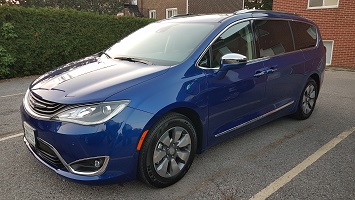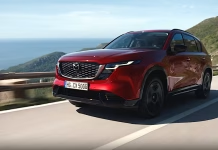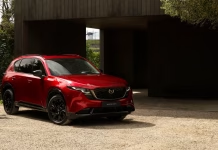THE PROS & CONS
What’s Best: Eminently practical and versatile, smooth and quiet ride, luxurious interior
What’s Worst: Length can make backing up a bit tricky, charge times can be long, pricey at the top end
What’s Interesting: The Pacifica Hybrid is currently the only plug-in hybrid minivan on the market
Driving the Chrysler Pacifica Hybrid – or any minivan, for that matter – is a bit of a strange experience for yours truly.
As a single guy with no kids (sorry Mom), I am most certainly not the target demographic for a vehicle that can seat seven comfortably and has enough available cargo space that one could live in it, and with plenty of room to spare.
But all that space and versatility is wasted when it’s being driven by someone like me – I just don’t have enough life to fill this thing up and really take advantage of its substantial versatility.
And yet, after spending a week driving one recently, the Pacifica Hybrid’s many charms have left their mark on me. Simply put, it’s a vehicle that makes sense for just about anyone in need of transportation, regardless of their circumstances. More on that later.
The Pacifica and Pacifica Hybrid were introduced as replacements for the Chrysler Town & Country at the 2016 Detroit Auto Show. Available in both gas and plug-in hybrid models, the 2017 Pacifica roll-out began in mid-2016 with the plug-in hybrid model following in early 2017.
New structure, new powertrain
Like its Town & Country predecessor and its mechanical twin the Dodge Grand Caravan, the new Pacifica is built in Fiat Chrysler Automobile’s (FCA) Windsor, Ontario assembly plant, but the new van is markedly different from its relatives.
Obviously, the Town & Country was never offered as a plug-in hybrid, so electrification is a key differentiator. Another is the platform it’s built on. Whereas the Town & Country and Grand Caravan are products of the aging RT-platform which dates to 2007, the Pacifica is built on Compact U.S-Wide, which is a longer variant of FCA’s Compact architecture shared with the Jeep Cherokee.
FCA engineers moved the Pacifica to this platform for a few key reasons, among them are improved ride, better handing and reduced noise, vibration and harshness (NVH). The Pacifica’s steel unibody structure is also lighter and stiffer – the stiffest in its class, according to FCA – for reduced body roll and a better ride over rough road surfaces. Most body panels are steel, save for those that cover the dual sliding doors (aluminum) and the rear power liftgate (magnesium). The Pacifica also has a much slipperier profile than the Town & Country and Grand Caravan, and the improved aero efficiency translates into better fuel economy.
As with all hybrids, the big story with the Pacifica Hybrid is the powertrain. Under the hood is an adapted variant of the 3.6-litre Pentastar V6 that works in conjunction with two electric motors and a 16-kWh lithium-ion battery pack and a 6.6-kWh on-board charger. Power is put to the ground through the front wheels via an eFlite electronically variable transmission (EVT). Combined system output is rated at 260 horsepower.
The Pacifica Hybrid rides on independent MacPherson struts up front and an independent twist-blade set-up in the rear. Disc brakes (13-inch) provide stopping power at all four corners – vented discs up front, solid at the rear.
With the basics out of the way, time for the two most important plug-in numbers: electric range and charge times.
On a full charge, the Pacifica Hybrid is rated at 53 km of electric-only range, with a total range of 911 km. As for charging, a basic 120-volt (level 1) household wall socket will charge the a fully depleted battery pack back up to full in about 14 hours. Using a 240-volt charger (level 2) will cut that time dramatically to about 2 hours.
During the week I spent with a range-topping Limited press unit finished in Ocean Blue metallic, the maximum electric range I was able to achieve was 55 km, and it took between 8 and 12 hours to charge it fully using a 120-volt plug. I should note, however, that I usually didn’t deplete the battery completely.
Coast to Coast on Electric Power in Canada? Almost
Versatile and luxurious
Minivans sell on versatility, plain and simple. The ability to cram these things full of people and their stuff is the main reason consumers – especially those with kids – have been flocking to minivans since FCA started building them in 1983.
Even in the current mid-size SUV age in North America, the FCA vans still sell surprisingly well. Despite its age, the Grand Caravan has sold 27,466 units through Sept. 30, while the Pacifica (gas and hybrid) has moved 5,327, good for a 14.6 percent increase.
Bottom line, the proposition a minivan presents is still relevant to consumers in 2018 and, as I discovered with the Pacifica Hybrid, it’s not just because of the utility. I’ll get to that shortly, but first a bit on the aesthetic of this vehicle, because it is far from what one might expect in a minivan.
Simply put, the Pacifica Hybrid isn’t the minivan from your childhood. From the heated and cooled Nappa leather seats and heated steering wheel, to the second-row captains chairs, 8.4-inch Uconnect infotainment screen, the Pacifica Hybrid delivers a premium cabin experience.
Given my tester is a range-topping Limited that checks at just over $60,000 before taxes, some of the standard kit was expected, but even accounting for that the Pacifica Hybrid is much more than a fancy clone of the Grand Caravan. The soft-touch trim materials, active noise cancellation and acoustic windshield speak to FCA’s efforts to create a more serene interior ambience.
Alrightey then – let’s get to the utility because, as you’d expect, there’s a ton of it.
Among the highlights:
7-passenger seating
Dual power sliding doors
Power liftgate
Third-row Stow ‘n Go 60/40 split fold seats that can fold flat into the floor
2,478 litres of interior cargo volume behind the first row; 3,979 behind the first row
Front-row USB and 12-volt charge ports
Second and third-row USB charge ports
Storage cubbies and cup holders everywhere (okay, so I didn’t count them all but there are a lot, trust me)
I’d be remiss if I didn’t also mention the rather lengthy suite of safety tech my tester comes stocked with, which includes lane departure warning, adaptive cruise control, forward collision warning with active braking and a 360-degree camera.
Impressions
As I said at the outset, the Pacifica Hybrid isn’t aimed at someone like me, but its utility, efficiency and well-finished cabin are impressive.
It also delivers a whisper quiet ride – even with the gas engine running – which is not only a credit to the suspension, but also to the thicker-sidewall Nexen tires it comes outfitted with. The Pacifica Hybrid won’t blow anyone away with fast-twitch performance and on-rails handling – it is a minivan, after all – but it scooted along just fine in both full-electric and gas engine mode.
I also found the means of tracking energy consumption via the Uconnect and instrument cluster display to be informative and entertaining. I didn’t take full advantage of its customizability but enjoyed watching the digital animations of my real-time power consumption. The pin-sharp quality of the Uconnect graphics, generally, is quite impressive.
Speaking of energy consumption, even though I wasn’t meticulous about charging my test vehicle, I managed to use electric-only power for 56 percent of my travel during a week of driving (239.1 km EV, 187.3 km gas, 426.4 km total), which I thought was pretty good. Overall, my tester returned a combined observed fuel economy rating of 5.9L/100 km, which is impressive for a large, 7-passenger vehicle.
Beyond all that, however, what really stuck with me after I returned my tester is how effortless the Pacifica Hybrid driving experience is. Getting in, getting out, the higher driving position and comfortable seats and the slew of amenities – it’s hard not to like, regardless of what you may think of driving a minivan. There’s an ease to how everything works, and there’s something to be said for that.
Now, don’t get me wrong. As some may have figured out by now, I love fast and loud sports cars, with their big horsepower, neck-snapping acceleration and razor-sharp handling. Those cars are at the core of why I love what I do so much. Always have, always will.
But every now and then I like to step out of my comfort zone, just to remind myself there are other cars.
And the lesson I keep learning is that those others, like the Pacifica Hybrid, are just as compelling in their own right.














